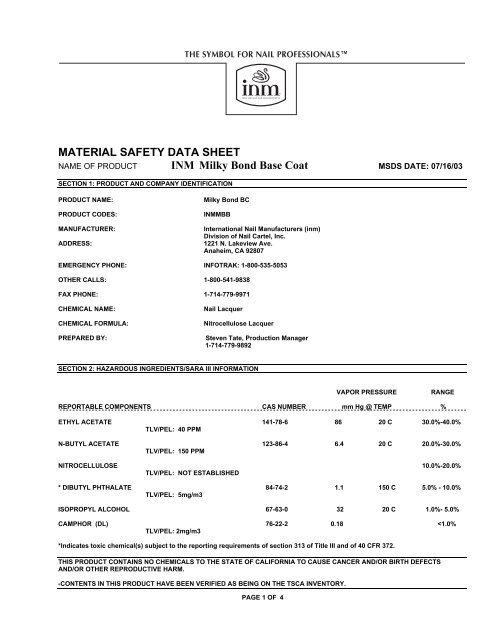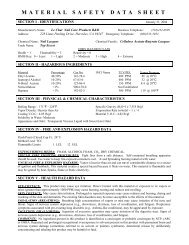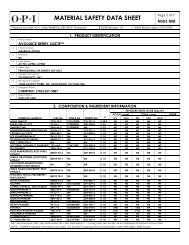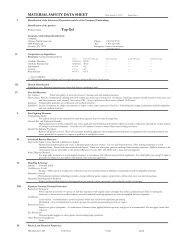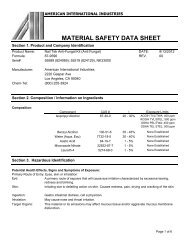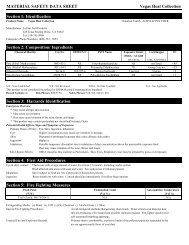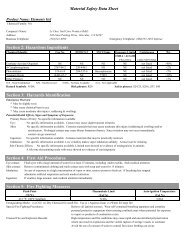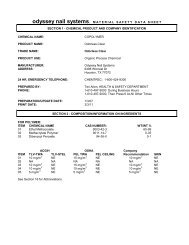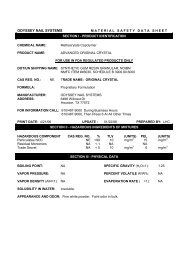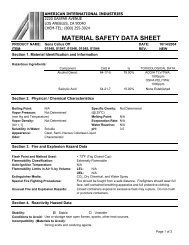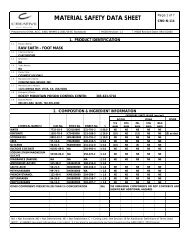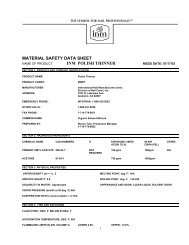MATERIAL SAFETY DATA SHEET INM Milky Bond Base Coat
MATERIAL SAFETY DATA SHEET INM Milky Bond Base Coat
MATERIAL SAFETY DATA SHEET INM Milky Bond Base Coat
Create successful ePaper yourself
Turn your PDF publications into a flip-book with our unique Google optimized e-Paper software.
<strong>MATERIAL</strong> <strong>SAFETY</strong> <strong>DATA</strong> <strong>SHEET</strong>NAME OF PRODUCT <strong>INM</strong> <strong>Milky</strong> <strong>Bond</strong> <strong>Base</strong> <strong>Coat</strong> MSDS DATE: 07/16/03SECTION 1: PRODUCT AND COMPANY IDENTIFICATIONPRODUCT NAME:PRODUCT CODES:MANUFACTURER:ADDRESS:<strong>Milky</strong> <strong>Bond</strong> BC<strong>INM</strong>MBBInternational Nail Manufacturers (inm)Division of Nail Cartel, Inc.1221 N. Lakeview Ave.Anaheim, CA 92807EMERGENCY PHONE: INFOTRAK: 1-800-535-5053OTHER CALLS: 1-800-541-9838FAX PHONE: 1-714-779-9971CHEMICAL NAME:CHEMICAL FORMULA:PREPARED BY:Nail LacquerNitrocellulose LacquerSteven Tate, Production Manager1-714-779-9892SECTION 2: HAZARDOUS INGREDIENTS/SARA III INFORMATIONPAGE 1 OF 4VAPOR PRESSURE RANGEREPORTABLE COMPONENTS CAS NUMBER mm Hg @ TEMP %ETHYL ACETATE 141-78-6 86 20 C 30.0%-40.0%TLV/PEL: 40 PPMN-BUTYL ACETATE 123-86-4 6.4 20 C 20.0%-30.0%TLV/PEL: 150 PPMNITROCELLULOSE 10.0%-20.0%TLV/PEL: NOT ESTABLISHED* DIBUTYL PHTHALATE 84-74-2 1.1 150 C 5.0% - 10.0%TLV/PEL: 5mg/m3ISOPROPYL ALCOHOL 67-63-0 32 20 C 1.0%- 5.0%CAMPHOR (DL) 76-22-2 0.18
<strong>MATERIAL</strong> <strong>SAFETY</strong> <strong>DATA</strong> <strong>SHEET</strong>NAME OF PRODUCT <strong>INM</strong> <strong>Milky</strong> <strong>Bond</strong> <strong>Base</strong> <strong>Coat</strong> MSDS DATE: 07/16/03SECTION 3: HAZARDS IDENTIFICATIONBOILING RANGE: 171 F - 228 F DENSITY: 8.03 lb/glVAPOR DENSITY: HEAVIER THAN AIREVAPORATION RATE: (M – BUTYL ACETATE = 1): > 1.0COATING V.O.C.: 4.01 lb/gl<strong>MATERIAL</strong> V.O.C.: 3.98 lb/glSOLUBILITY IN WATER: MODERATEAPPEARANCE AND ODOR: TRANSPARENT VISCOUS LIQUID WITH SWEET ESTER ODORSECTION 4: FIRE AND EXPLOSION HAZARD <strong>DATA</strong>FLASH POINT: 77 Deg. F.METHOD USED: Pensky-Martens Closed Tester ASTM D93FLAMMABLE LIMITS INAIR BY VOUME - LOWER: 0.5 UPPER: 12EXTINGUISHING MEDIA: Water is the most effective fire-extinguishing medium for Nitrocellulose. It is recommendedto be used in large volume. Dry chemical, C02 or a universal type foam could be used to extinguish small fires.SPECIAL FIREFIGHTING PROCEDURES: Wear self-contained breathing apparatus and protective clothing to preventcontact with skin and eyes. Use water spray to keep fire exposed containers cool.UNUSUAL FIRE AND EXPLOSION HAZARD: Handle as flammable liquid. Vapors form an explosive mixture in air betweenthe upper and lower explosive limits which can be ignited by many sources such as pilot lights, open flames,electrical motors and switches.SECTION 5: REACTIVITY <strong>DATA</strong>STABILITY: StableCONDITIONS TO AVOID: Flame, electric spark, static, and heat.INCOMPATIBILITY (<strong>MATERIAL</strong>S TO AVOID): This product is incompatible with strong acids or based and oxidizers.HAZARDOUS DECOMPOSITION OR BY PRODUCTS: Thermal decomposition in the presence of air may yield carbondioxide, and nitrogen oxide. Under some conditions, methane, irritating aldehydes and carbonxylic acidsand hydrogen cyanide may be formed.HAZARDOUS POLYMERIZATION: WILL NOT OCCURSECTION 6: HEALTH HAZARD <strong>DATA</strong>INHALATION HEALTH RISKS AND SYMPTOMS OF EXPOSURE: Breathing high concentrations of vapors or mists maycause irritation of the nose and throat. Signs of nervous system depression (e.g. drowsiness, dizziness, lossof coordination, and fatigue).SKIN AND EYE CONTACT HEALTH RISKS AND SYMPTOMS OF EXPOSURE:EYE: This product may cause eye irritation. Direct contact with this material or exposure to its vapors or mists(greater than approximately 1000 ppm) may cause burning, tearing, redness, and swelling.SKIN: This product may cause skin irritation. Prolonged or repeated exposure to this material may cause rednessand burning, drying and cracking of and dermatitis.INGESTION HEALTH RISKS AND SYMPTOMS OR EXPOSURE: Ingestion of excessive quantities may cause irritation ofthe digestive tract. Sign of nervous system depression (e.g., drowsiness, dizziness, loss of coordination, andfatigue).HEALTH HAZARDS (ACUTE AND CHRONIC): No ingredient present in this product is identified as a carcinogen orprobable carcinogen by NTP, IARC, or OSHA. Reports have associated repeated and prolongedPAGE 2 OF 4
<strong>MATERIAL</strong> <strong>SAFETY</strong> <strong>DATA</strong> <strong>SHEET</strong>NAME OF PRODUCT <strong>INM</strong> <strong>Milky</strong> <strong>Bond</strong> <strong>Base</strong> <strong>Coat</strong> MSDS DATE: 07/16/03occupational overexposure to solvent present in this product with permanent brain and nervous systemdamage (sometimes referred to as solvent or painter’s syndrome). Intentional misuse by deliberatelyconcentrating and inhaling this product may be harmful or fatal.CARCINOGENTICITY: NTP CARCINOGEN: NoIARC MONOGRAPHS: NoOSHA REGULATED: NoMEDICAL CONITIONS CENERALLY AGGRAVATED BY EXPOSURE: Respiratory symptoms associated with pre-existinglung disorders (e.g., asthma-like conditions) may be aggravated by exposure to the vapors of this material.Persons with pre-existing skin disorders may be more susceptible to the effects of this material.EMERGENCY AND FIRST AID PROCEDURES:-Inhalation: In case of irritation by vapor, remove from exposure, treat symptomatically, and get medical attentionof symptoms persists.-Eyes: Any material that contacts the eye should be washed out immediately and medical attention obtainedif symptoms persist.-Skin: Wash with soap and plenty of water.-Ingestion: Call a physician or poison control center immediately. Induce vomiting as directed by medical personnel.Never give anything by mouth to an unconscious person.SECTION 7: PRECAUTIONS FOR SAFE HANDLING AND USESTEPS TO BE TAKEN IN CASE <strong>MATERIAL</strong> IS RELEASED OR SPILLED: Highway or railway spills call INFOTRAK: 1-800-535-5053within the USA, for International 1-352-323-3500.Stay upwind and away from spill. Keep all sources of ignition and hot metal surfaces away from spill. Keep out ofdrains, sewers, or waterway. Use sand or other inert material to dam and contain spill. Do not flush with water; useabsorbent pads. For large spills call response team and notify appropriate state/local agencies. Immediately notifythe National Reponse Center (phone number: 800-424-8802) in case if the spill is in excess of EPA reportable quantity.WASTE DISPOSAL METHOD: Dispose of product in accordance with local, county, state, and federal regulations.PRECAUTIONS TO BE TAKEN IN HANDLING AND STORING: Use non-sparking utensils when handling this material.Keep containers, tightly closed, cool, dry and away from sources of ignition.OTHER PRECAUTIONS: Smoking in area where this material is used should be strictly prohibited. Use with adequateventilation. If normal ventilation is not adequate use with NIOSH approved respirator or exhaust fan.SECTION 8: CONTROL MEASURESPREVENTIVE MEASURES: Keep containers and storage containers closed when not in use. Do not store near heat,sparks, flame, or strong oxidants. While transferring this material the containers used in this process hasto be effectively grounded (ultimately to an earth ground) to prevent fire or explosion risk from staticaccumulation in accordance with the National Fire Protection Association standard for petroleum products.VENTILATION: The ventilation system should be designed to be able to maintain airborne concenteations below theestablished exposure limits. If the current ventilation is not aequate to maintain this level, additional ventilationor exhaust systems may be required. Use explosion proof equipment.RESPIRATORY PROTECTION: When vapor concentration exceed the established exposure limits respiratory protection isnecessary. Depending on the airborne concentration, use a respirator or gas mask with appropriate cartridges andcanisters (NIOSH approved organic vapor) or supplied air equipment.PROTECTIVE GLOVES: The use of gloves impermeable to the specific material handled is advised to prevent skincontact and possible irritation.EYE PROTECTION: Safety glasses with side shields ( or goggles) are recommended for any types of industrial chemicalhandling.OTHER PROTECTIVE CLOTHING OR EQUIPMENT: The use of gloves impermeable to the specific material handledis advised to prevent skin contact and possible irritation. Use splash goggles (NIOSH approved) tosafeguard against potential eye contact, irritation or injury.PAGE 3 OF 4
<strong>MATERIAL</strong> <strong>SAFETY</strong> <strong>DATA</strong> <strong>SHEET</strong>NAME OF PRODUCT <strong>INM</strong> <strong>Milky</strong> <strong>Bond</strong> <strong>Base</strong> <strong>Coat</strong> MSDS DATE: 07/16/03WORK/HYGIENIC PRACTICES: Minimize breathing vapor or mist. Avoid prolonged or repeated contact withskin. Maintain a source of clean water to be available in work area for flushing eyes and skin.Removed contaminated clothing; launder or dry-clean before use. Remove contaminated shoes andthoroughly clean and dry before reuse. Cleanse skin thoroughly after contact, before breaks andmeals, and at end of the work period. Product is readily removed from skin by waterless hand cleanersor solvents (acetone or esters) followed by washing with soap and water. Impervious clothing should beworn as needed.SECTION 9: SHIPPING INFORMATIONProper Shipping Name: PaintDOT Hazard Class: 3 (Flammable Liquid)Packaging Group: PG IIIUN ID Number: 1263SECTION 10: DICLAIMERTo the best of our knowledge, the information contained herein is accurate, obtained from sources believed by <strong>INM</strong> to beaccurate. As with all chemicals, KEEP AWAY FROM CHILDREN AND ANIMALS. FOR TOPICAL USE ONLY.PAGE 4 OF 4


